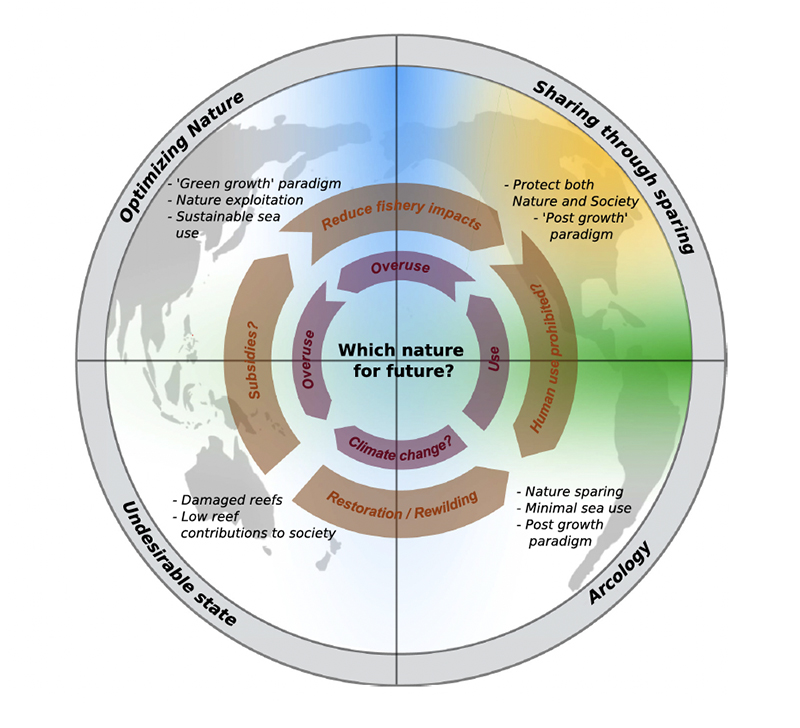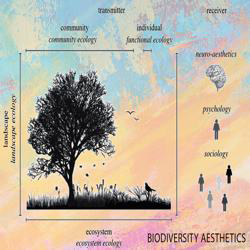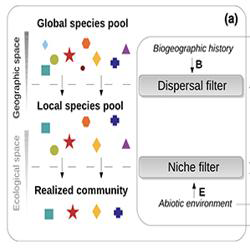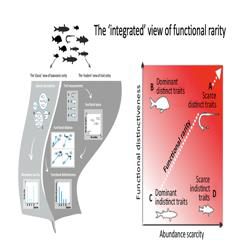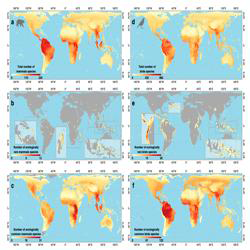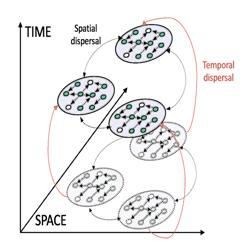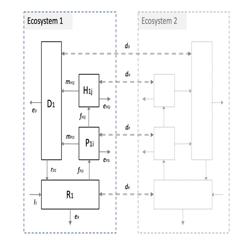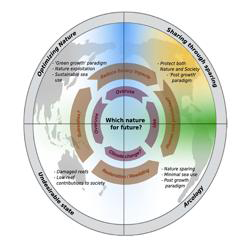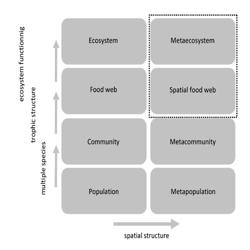|
Nature for Future
The Nature Futures Framework (NFF) envisions pathway for biodiversity conservation that integrate nature's intrinsic, instrumental and relational values to support both human well-being and ecological resilience (Pereira et al. 2020). Closely aligned with the Nature's Contributions to People (NCP) framework (Pascual et al. 2017, Diaz et al. 2020), the NFF goes further, by clearly integrating that nature has intrinsic value (self-sustaining capacity) beyond serving human needs. The NFF advocates for conservation policies that value ecosystems not just as resources for people, but as complex, interconnected and (hopefully still) self-sustainable systems. This approach enriches biodiversity conservation approaches by promoting coexistence strategies that respect ecological integrity alongside human well-being.
The NFF redefines ecosystem services by recognizing the multiple ways in which nature benefits people - including cultural, identity-based, and relational values. Together, the NFF and NCP frameworks envision biodiversity protection as a foundational element for resilience and a sustainable future for humanity.
L. M. Pereira, K. K. Davies, E. den Belder, S. Ferrier [...] and C. J. Lundquist, Developing multiscale and integrative nature people scenarios using the Nature Futures Framework. People and Nature 2, 1172-1195 (2020).
S. Diaz, U. Pascual, M. Stenseke, B. Martin-Lopez, R. T. Watson [...] and Y. Shirayama, Assessing nature s contributions to people. Science 359, 270-272 (2018).
U. Pascual, P. Balvanera, S. Díaz, G. Pataki [...] and N. Yagi, Valuing nature s contributions to people: the IPBES approach. Current Opinion in Environmental Sustainability 26-27, 7-16 (2017).
My previous research naturally led me to this framework, which offers incredible challenges and opportunities. Challenges to measure such interlinked human-nature relationships, to provide new concepts and methods, and to work with other fields of research; opportunities because it is a once-in-a-lifetime opportunity to make a difference: if we (ecologists) do not fully commit ourselves to this research field, who will?
It is difficult to select past work along this framework because the NFF is so vast and most of my past research simply fits into the Nature for Nature corner of the NFF. Rather, I will list here some work that fits into the NFF triangle without being too close to any single corner.
Back to Nicolas Mouquet homepage
|
Which future for tropical reefs? The four parts defined by the gradient of nature protection and exploitation illustrate different possible futures, exposed by the NFF. Optimizing nature for humans propose a biocultural and social future where societies exploit whatever is necessary for human well-being as long as it is sustainable. Arcology calls for a future where people are concentrated in dense, futuristic, self-sufficient cities, surrounded by totally pristine nature. Between both, Sharing through sparing depicts a future where people exploit as little of nature as possible for their well-being and safeguard the remainder. Flandrin U., Mouillot D., [...] & Mouquet N. (2024) Fish communities can simultaneously contribute to nature and people across the worlds tropical reefs One Earth 7, 1772–1785.
|
|
Human for nature : building a better future for biodiversity
|
|
|
Mouillot D., Velez L., Albouy C., Casajus N., Claudet J., Delbar V., Devillers R., Letessier T.B., Loiseau N., Manel M., Mannocci L., Meeuwig J., Mouquet N., Nuno A., OConnor L., Parravicini P., Renaud J., Seguin R.,Troussellier T. & Thuiller W. (2024) The socioeconomic and environmental niche of protected areas reveals global conservation gaps and opportunities Nature Communications 15:9007. DOI:10.1038/s41467-024-53241-1
|
|
|
|
Loiseau N., Mouillot D., Velez L., Seguin R., Casajus N., Coux C., Albouy C., Claverie T., Duhamet A., Fleure V., Langlois J., Villeger S. & Mouquet N. (2024) Inferring the extinction risk of marine fish to inform global conservation priorities PLOS Biology 22, e3002773. DOI:10.1371/journal.pbio.3002773
|
|
|
|
Letessier T.B., Mouillot D., Mannocci L., Jabour Christ H., Elamin Mohammed E., Mohamed Elamin S., Friedlander A.M., Alex Hearn. A., Juhel J.B., Ring Kleiven A., Moland E., Mouquet N., Nillos-Kleiven P.J., Sala E., Thompson C.D.H., Velez L., Vigliola, L., Meeuwig J.J. (2024) Divergent responses of pelagic and benthic fish body-size structure to remoteness and protection from humans Science, 383, 976:982. DOI:10.1126/science.adi7562
|
|
|
|
Nature for human : acknowledging our human nature beyond nature exploitation
|
|
|
Alisa, C.A.G., Razak, T.B., Mouquet N.*,Graham A.J, HemingsonC. R. ,Mouillot D., Damayanti, L. Prasetya M. E. , Maulana P. B., Hamka A. , Dwiyanto A., Abeng A. T., Madjid, Irwan, R. E., Hidayat A., Lakota H., Parrangan C. V., Pratama A. M. A., Hamzah, Suandar, Subhan B., Zamani N. P., Vida R. T. & Lamont, T. A. C. (2025). Benthic communities on restored coral reefs confer equivalent aesthetic value to healthy reefs Scientific Reports 15, 20790. doi.org/10.1038/s41598-025-06373-3
|
|
|
|
McLean M.*, Mouillot D., Langlois J., Arif S., Bejarano S., Casajus C., Edgar G.J., Flandrin U., Guilhaumon F., Judah A.B., Loiseau N., MacNeil M.A., Maire E., Stuart-Smith R.D., & Mouquet N.* (2025). Conserving the beauty of the worlds reef fish assemblages Proc. Natl. Acad. Sci. U.S.A. 122 (25) e2415931122, doi.org/10.1073/pnas.2415931122 (* These authors contributed equally to this study)
|
|
|
|
Zeller K., Mouquet N., Garcia C., Dezecache G., Maille A., Duboscq J., Morino J.L., & Bonnet X. (2025). Danger versus fear: A key to understanding biophobia People and Nature, doi: 10.1002/pan3.70009
|
|
|
|
Flandrin U., Mouillot D., Albouy C., Bejarano S., Casajus C., Cinner J., Edgar G., Ghilardi M, Leprieur L., Loiseau L., MacNeil A., Maire E., McLean M., Parravicini V., Pellissier L., Schiettekatte N., Stuart-Smith R., Villeger S. & Mouquet N. (2024) Fish communities can simultaneously contribute to nature and people across the worlds tropical reefs One Earth 7, 1772-1785. DOI:10.1016/j.oneear.2024.09.011/
|
|
|
|
Mouquet N., Langlois J., Casajus N., Auber A., Flandrin U., Guilhaumon F., Loiseau N., McLean M., Aurore R., Stuart Smith R.D. & Mouillot D. (2024) Low human interest for the most at-risk reef fishes worldwide Science Advances, 10,eadj9510. DOI:10.1126/sciadv.adj9510. This paper was featured in Science Advances by Becca Franks: Vulnerable fishes, inattentive humans
|
|
|
|
Bockel T., Bossut N., Mouquet N., Mouillot D. & Deter J. (2024) Quantifying the impact of small boats on Posidonia seagrass meadows: Methods and path for future efficient management of anchoring pressure Ocean and Coastal Management 259, DOI:10.1016/j.ocecoaman.2024.107454
|
|
|
|
Bockel T., Marre G., Delaruelle G., Agel N., Boissery P., Guilhaumon F., Mouquet N., Mouillot D. & Deter J. (2024) Early signals of Posidonia oceanica meadows recovery in a context of wastewater treatment improvements Marine Pollution Bulletin 201, DOI:10.1016/j.marpolbul.2024.116193
|
|
|
|
Tribot AS, Blanc N, Brassac T, Guilhaumond F, Casajus N, and Mouquet N (2023) What makes a teddy bear comforting? A participatory study reveals the prevalence of sensory characteristics and emotional bonds in the perception of comforting teddy bears The Journal of Positive Psychology, DOI:10.1080/17439760.2023.2170273
|
|
|
Langlois J, Guilhaumon F, Baletaud F, Casajus N, De Almeida Braga C, Fleure V, Kulbicki K, Loiseau N, Mouillot D, Renoult JP, Stahl A, Stuart Smith RD, Tribot AS & N, Mouquet (2022) The aesthetic value of reef fishes is globally mismatched to their conservation priorities. PLoS Biol 20(6): e3001640. doi:10.1371/journal.pbio.3001640
|
|
|
|
Langlois J, Guilhaumon F, Bockel T, Boissery P, De Almeida Braga C, Deter J, Holon F, Marre G, Tribot AS & Mouquet N (2021) An integrated approach to estimate aesthetic and ecological values of coralligenous reefs. Ecological Indicators, 129, 107935, doi:10.1016/j.ecolind.2021.107935
|
|
|
|
Tribot, A.S, Deter, J., Claverie, T., Guillhaumon, F., Villeger, S., & Mouquet, N. (2019). Species diversity and composition drive the aesthetic value of coral reef fish assemblages. Biology letters, 15, 20190703, doi:10.1098/rsbl.2019.0703
|
|
|
|
Tribot, A.S, Carabeux, Q., Deter, J., Claverie, T., Villeger, S., & Mouquet, N. (2018). Confronting species aesthetics with ecological functions in coral reef fish. Scientific Reports, 8, 11733, doi:10.1038/s41598-018-29637-7
|
|
|
|
Tribot, A.S.,Mouquet, N., Villeger, S., Raymond, M., Hoff, F., Boissery, P., Holon, F., Deter, J. (2016). Taxonomic and functional diversity increase the aesthetic value of coralligenous reefs. Scientific Reports, doi:10.1038/srep34229
|
|
|
